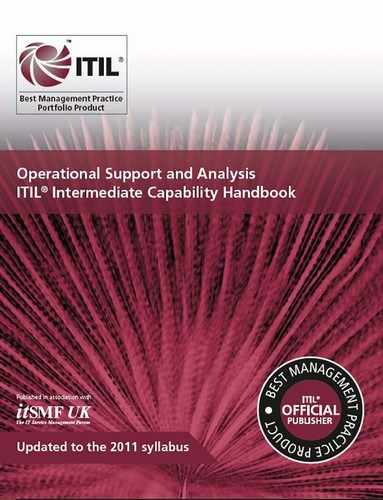0%
20Chapters
0-1Hours read
0kTotal Words
Book Description
The Operational Support and Analysis (OSA) syllabus, this quick-reference guide will help you as you study for the OSA module of the ITIL Intermediate Capability qualification. Beyond the exam, this handbook is a practical resource that can be used in the workplace.
Table of Contents
- Copyright Page
- Contents
- Acknowledgements
- About this guide
- 1. Introduction to service management
- 2. Event management
- 2.1. Purpose and objectives (SO 4.1.1)
- 2.2. Scope (SO 4.1.2)
- 2.3. Value to the business and service lifecycle (SO 4.1.3)
- 2.4. Policies, principles and basic concepts (SO 4.1.4)
- 2.5. Process activities, methods and techniques (SO 4.1.5)
- 2.6. Triggers, inputs, outputs and interfaces (SO 4.1.6)
- 2.7. Information management (SO 4.1.7)
- 2.8. Critical success factors and key performance indicators (SO 4.1.8)
- 2.9. Challenges and risks (SO 4.1.9)
- 2.10. Roles and responsibilities (SO 6.7.8)
- 3. Incident management
- 3.1. Purpose and objectives (SO 4.2.1)
- 3.2. Scope (SO 4.2.2)
- 3.3. Value to the business and service lifecycle (SO 4.2.3)
- 3.4. Policies, principles and basic concepts (SO 4.2.4)
- 3.5. Process activities, methods and techniques (SO 4.2.5)
- 3.6. Triggers, inputs, outputs and interfaces (SO 4.2.6)
- 3.7. Information management (SO 4.2.7)
- 3.8. Critical success factors and key performance indicators (SO 4.2.8)
- 3.9. Challenges and risks (SO 4.2.9)
- 3.10. Roles and responsibilities (SO 6.7.5)
- 4. Request fulfilment
- 4.1. Purpose and objectives (SO 4.3.1)
- 4.2. Scope (SO 4.3.2)
- 4.3. Value to the business and service lifecycle (SO 4.3.3)
- 4.4. Policies, principles and basic concepts (SO 4.3.4)
- 4.5. Process activities, methods and techniques (SO 4.3.5)
- 4.6. Triggers, inputs, outputs and interfaces (SO 4.3.6)
- 4.7. Information management (SO 4.3.7)
- 4.8. Critical success factors and key performance indicators (SO 4.3.8)
- 4.9. Challenges and risks (SO 4.3.9)
- 4.10. Roles and responsibilities (SO 6.7.7)
- 5. Problem management
- 5.1. Purpose and objectives (SO 4.4.1)
- 5.2. Scope (SO 4.4.2)
- 5.3. Value to the business and service lifecycle (SO 4.4.3)
- 5.4. Policies, principles and basic concepts (SO 4.4.4)
- 5.5. Process activities, methods and techniques (SO 4.4.5)
- 5.6. Triggers, inputs, outputs and interfaces (SO 4.4.6)
- 5.7. Information management (SO 4.4.7)
- 5.8. Critical success factors and key performance indicators (SO 4.4.8)
- 5.9. Challenges and risks (SO 4.4.9)
- 5.10. Roles and responsibilities (SO 6.7.6)
- 6. Access management
- 6.1. Purpose and objectives (SO 4.5.1)
- 6.2. Scope (SO 4.5.2)
- 6.3. Value to the business and service lifecycle (SO 4.5.3)
- 6.4. Policies, principles and basic concepts (SO 4.5.4)
- 6.5. Process activities, methods and techniques (SO 4.5.5)
- 6.6. Triggers, inputs, outputs and interfaces (SO 4.5.6)
- 6.7. Information management (SO 4.5.7)
- 6.8. Critical success factors and key performance indicators (SO 4.5.8)
- 6.9. Challenges and risks (SO 4.5.9)
- 6.10. Roles and responsibilities (SO 6.7.9)
- 7. Service desk
- 8. Service operation functions
- 9. Technology and implementation
- 9.1. Generic requirements for IT service management technology (SO 7.1)
- 9.2. Evaluation criteria for technology and tools (SD 7.2)
- 9.3. Evaluation criteria for technology and tools for process implementation
- 9.4. Practices for process implementation
- 9.5. Challenges, critical success factors and risks relating to implementing practices and processes
- 9.6. Planning and implementing service management technologies (SO 8.5)
- 10. Qualifications
- 11. Related guidance (SO Appendix A)
- 11.1. ITIL guidance and web services
- 11.2. Quality management system
- 11.3. Risk management
- 11.4. Governance of IT
- 11.5. COBIT
- 11.6. ISO/IEC 20000 service management series
- 11.7. Environmental management and green and sustainable IT
- 11.8. ISO standards and publications for IT
- 11.9. ITIL and the OSI framework
- 11.10. Programme and project management
- 11.11. Organizational change
- 11.12. Skills Framework for the Information Age
- 11.13. Carnegie Mellon: CMMI and eSCM frameworks
- 11.14. Balanced scorecard
- 11.15. Six Sigma
- Further guidance and contact points
- Glossary
- Back Cover
